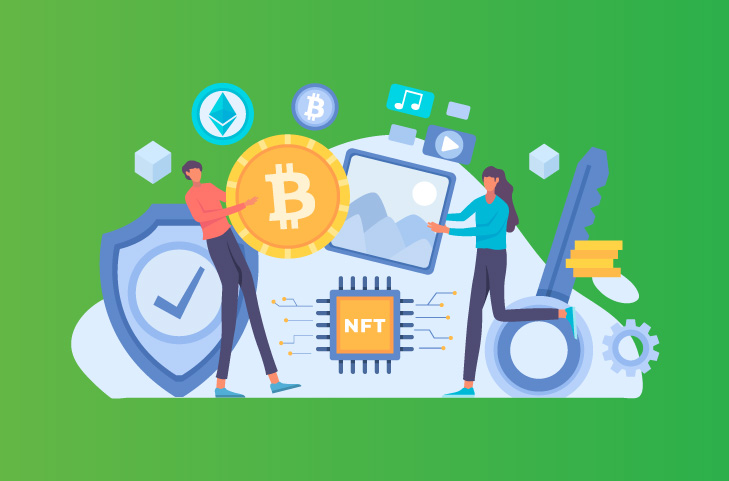What is Web 3.0 Anyway?
In technical terms, Web 3.0 is a decentralized online ecosystem. It is built around the idea of a semantic web with no central authority. It is made with open-source software in full public view to enable trustless and permission less engagement for the end-user. And powered by the following technological innovations:
- Blockchain
- Edge computing
- Decentralization
- ML & AI
Or, from the user’s perspective, Web 3.0 is the type of web where people can create, read, and interact with content across websites and applications. Just think of how people are using their “Avatars” to meet other people in the Metaverse, and you have a glimpse of what the concept is all about.
Moreover, since Web 3.0 will run on blockchain networks, all data will become immutable and let the users own it instead of selecting companies.
This is why Bitcoin, dApps, NFTs, Metaverse, DAOs, and other decentralized technologies have become the talk of the town already. With the NFTs on the rise and dApps replacing their Web 2.0 counterparts, the mass adoption of Web 3.0 by common men and big tech names comes as no surprise. However, these technologies are still emerging and will take time before they’re fully integrated with the existing systems.
Nonetheless, if Web 3.0 technologies are refined in the pro-privacy and anti-monopoly manner they are deemed to support, the new generation will affect a broad selection of industries. And redefine how consumers interact with branded content online.
Now, as a business-to-business marketer, where do you fit into the picture?
What B2B Marketers Should Know About Web 3.0

Gavin Wood, the co-creator of Ethereum, who introduced the term “Web 3.0” in 2014, defined Web 3.0 as “Less trust, more truth.”
This means more openness and transparency in the way transactions happen between two businesses. All stakeholders will know the exact value and commerce they’re participating in without a middleman carrying out the process.
By extension, Web 3.0 will democratize the Internet, so the “authority” will rest with the people rather than the Big Tech. It will be community-driven, more private. This is also why Web 2.0 tactics won’t work for marketing based on Web 3.0.
From what we know of Web 3.0 so far, we can draw the following conclusions:
- Keyword optimization will lose ground. Web 3.0 will be all about a nuanced understanding of the user search needs and queries. Instead of word-to-word mapping, search engines will focus on the context of the queries. So your SEO strategy will need to shift to question-keyword and ‘People Also Ask’ optimization.
- Token-based incentives will rule the Internet. Most brands rely on community-led organic growth to acquire, nurture, convert, and retain users. With Web 3.0, you will have various methods of rewarding your community. Of those, token-based incentives like VIP access tokens for early product releases or your very own reward coin for content consumption will take the cake.
- Events in Metaverse will be a big thing. After Facebook was renamed “Meta,” search engines buzzed with the Metaverse queries. And why not? The idea of having 3D experiences is exciting as hell. Users can join and interact in digital environments as if they are meeting in real life. For the marketing and sales team, this could mean engaging all the stakeholders in one place to deal with the busy schedules of the decision-makers. You can also hold virtual events, conferences, and exhibitions in the Metaverse. The possibilities are endless.
- Hyper-personalized experience will become the key to sales. The ability of Web 3.0 to learn and interact with the users seamlessly will result in rich, personalized experiences. So static websites will become a thing of the past. To keep pace with it, you’ll need to rethink brand messaging and what media formats to use for earning better ROIs.
Some Examples of Web 3.0 Plays

Apple’s Siri
Whether you realize it or not, Siri was probably your introduction to the semantic Internet. However, in limited form. When you ask questions like “where is the nearest gas station?” Siri would use speech recognition and run a word-by-word search to answer the question. In the Web 3.0 world, Siri would seek contextualized knowledge, resulting in significantly better search results. This also means that, as a marketer, you can no longer rely on keyword optimization alone.
You’ll need to build a more nuanced understanding of consumer behavior and create the right digital assets to help search engines find them seamlessly. It’s what Iron Man’s Jarvis was all about.
Steemit
A social media network that pays you to use it? Sounds too good to be true, doesn’t it? But Steemit, a content-sharing site like Medium powered by the Steem blockchain, has been doing it since 2016. Yes, in rewards called Steem tokens, tradeable and convertible like any other currency. The only catch? Your content needs to have real value for the Steemit users.
As there is a monetary reward in the equation, users will only share or upvote your content if they find it useful. You may receive positive engagement if you’re serving “hot takes” about your industry or other high-value content.
Thus, if you can market the content right, you can boost user interaction, grow your audience, and eventually make good sales: one stone, multiple birds.
Bottom Line

The Web 3.0 revolution has been set in motion. Now, it’s no longer about if or how the blockchain-based technologies will disrupt the business as usual. But how you can harness the Web 3.0 technology to gain a competitive advantage and elevate your company’s value propositions.
All you need to do right now is keep a close watch on how Web 3.0 evolves to make the most of it in the near future.


